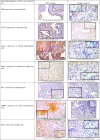Down-regulation of hepatic expression of GHR/STAT5/IGF-1 signaling pathway fosters development and aggressiveness of HCV-related hepatocellular carcinoma: Crosstalk with Snail-1 and type 2 transforming growth factor-beta receptor
- PMID: 36374927
- PMCID: PMC9662744
- DOI: 10.1371/journal.pone.0277266
Down-regulation of hepatic expression of GHR/STAT5/IGF-1 signaling pathway fosters development and aggressiveness of HCV-related hepatocellular carcinoma: Crosstalk with Snail-1 and type 2 transforming growth factor-beta receptor
Abstract
Background and aims: So far, few clinical trials are available concerning the role of growth hormone receptor (GHR)/signal transducer and activator of transcription 5 (STAT5)/insulin like growth factor-1 (IGF-1) axis in hepatocarcinogenesis. The aim of this study was to evaluate the hepatic expression of GHR/STAT5/IGF-1 signaling pathway in hepatocellular carcinoma (HCC) patients and to correlate the results with the clinico-pathological features and disease outcome. The interaction between this signaling pathway and some inducers of epithelial-mesenchymal transition (EMT), namely Snail-1 and type 2 transforming growth factor-beta receptor (TGFBR2) was studied too.
Material and methods: A total of 40 patients with HCV-associated HCC were included in this study. They were compared to 40 patients with HCV-related cirrhosis without HCC, and 20 healthy controls. The hepatic expression of GHR, STAT5, IGF-1, Snail-1 and TGFBR2 proteins were assessed by immunohistochemistry.
Results: Compared with cirrhotic patients without HCC and healthy controls, cirrhotic patients with HCC had significantly lower hepatic expression of GHR, STAT5, and IGF-1proteins. They also displayed significantly lower hepatic expression of TGFBR2, but higher expression of Snail-1 versus the non-HCC cirrhotic patients and controls. Serum levels of alpha-fetoprotein (AFP) showed significant negative correlations with hepatic expression of GHR (r = -0.31; p = 0.029) and STAT5 (r = -0.29; p = 0.04). Hepatic expression of Snail-1 also showed negative correlations with GHR, STAT5, and IGF-1 expression (r = -0.55, p = 0.02; r = -0.472, p = 0.035, and r = -0.51, p = 0.009, respectively), whereas, hepatic expression of TGFBR2 was correlated positively with the expression of all these proteins (r = 0.47, p = 0.034; 0.49, p = 0.023, and r = 0.57, p<0.001, respectively). Moreover, we reported that decreased expression of GHR was significantly associated with serum AFP level>100 ng/ml (p = 0.048), increased tumor size (p = 0.02), vascular invasion (p = 0.002), and advanced pathological stage (p = 0.01). Similar significant associations were found between down-regulation of STAT5 expression and AFP level > 100 ng/ml (p = 0.006), vascular invasion (p = 0.009), and advanced tumor stage (p = 0.007). Also, attenuated expression of IGF-1 showed a significant association with vascular invasion (p < 0.001). Intriguingly, we detected that lower expression of GHR, STAT5 and IGF-1 were considered independent predictors for worse outcome in HCC.
Conclusion: Decreased expression of GHR/STAT5/IGF-1 signaling pathway may have a role in development, aggressiveness, and worse outcome of HCV-associated HCC irrespective of the liver functional status. Snail-1 and TGFBR2 as inducers of EMT may be key players. However, large prospective multicenter studies are needed to validate these results.
Copyright: © 2022 Abu El-Makarem et al. This is an open access article distributed under the terms of the Creative Commons Attribution License, which permits unrestricted use, distribution, and reproduction in any medium, provided the original author and source are credited.
Conflict of interest statement
The authors have declared that no competing interests exist.
Figures



Similar articles
-
Significant down-regulation of growth hormone receptor expression revealed as a new unfavorable prognostic factor in hepatitis C virus-related hepatocellular carcinoma.Clin Mol Hepatol. 2021 Apr;27(2):313-328. doi: 10.3350/cmh.2020.0247. Epub 2020 Dec 14. Clin Mol Hepatol. 2021. PMID: 33317258 Free PMC article.
-
Impairment of GH/IGF-1 Axis in the Liver of Patients with HCV-Related Chronic Hepatitis.Horm Metab Res. 2018 Feb;50(2):145-151. doi: 10.1055/s-0043-118911. Epub 2017 Sep 18. Horm Metab Res. 2018. PMID: 28922679
-
The somatotropic axis during the physiological estrus cycle in dairy heifers--Effect on hepatic expression of GHR and SOCS2.J Dairy Sci. 2015 Apr;98(4):2409-18. doi: 10.3168/jds.2014-8734. Epub 2015 Feb 20. J Dairy Sci. 2015. PMID: 25704974
-
Growth hormone stimulates hepatic expression of bovine growth hormone receptor messenger ribonucleic acid through signal transducer and activator of transcription 5 activation of a major growth hormone receptor gene promoter.Endocrinology. 2007 Jul;148(7):3307-15. doi: 10.1210/en.2006-1738. Epub 2007 Apr 5. Endocrinology. 2007. PMID: 17412814
-
Growth hormone-STAT5 regulation of growth, hepatocellular carcinoma, and liver metabolism.Ann N Y Acad Sci. 2011 Jul;1229:29-37. doi: 10.1111/j.1749-6632.2011.06100.x. Ann N Y Acad Sci. 2011. PMID: 21793836 Free PMC article. Review.
Cited by
-
The Malignant Transformation of Viral Hepatitis to Hepatocellular Carcinoma: Mechanisms and Interventions.MedComm (2020). 2025 Mar 8;6(3):e70121. doi: 10.1002/mco2.70121. eCollection 2025 Mar. MedComm (2020). 2025. PMID: 40060195 Free PMC article. Review.
-
New insights into biomarkers and risk stratification to predict hepatocellular cancer.Mol Med. 2025 Apr 23;31(1):152. doi: 10.1186/s10020-025-01194-6. Mol Med. 2025. PMID: 40269686 Free PMC article. Review.
-
The oncogenic mechanisms of the Janus kinase-signal transducer and activator of transcription pathway in digestive tract tumors.Cell Commun Signal. 2024 Jan 25;22(1):68. doi: 10.1186/s12964-023-01421-9. Cell Commun Signal. 2024. PMID: 38273295 Free PMC article. Review.
-
HCC spatial transcriptomic profiling reveals significant and potentially targetable cancer-endothelial interactions.Hepatol Commun. 2024 Sep 27;8(10):e0533. doi: 10.1097/HC9.0000000000000533. eCollection 2024 Oct 1. Hepatol Commun. 2024. PMID: 39330965 Free PMC article.
-
Genes selection using deep learning and explainable artificial intelligence for chronic lymphocytic leukemia predicting the need and time to therapy.Front Oncol. 2023 Aug 31;13:1198992. doi: 10.3389/fonc.2023.1198992. eCollection 2023. Front Oncol. 2023. PMID: 37719021 Free PMC article.
References
MeSH terms
Substances
LinkOut - more resources
Full Text Sources
Medical
Research Materials
Miscellaneous

